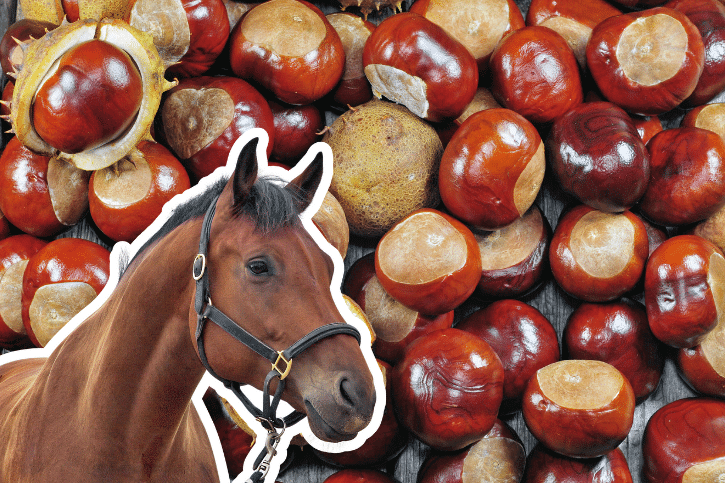Can Horses Eat Horse Chestnuts?
With fall just around the corner, we’re soon to see the staple of the season strewn across all our streets: the horse chestnut.
Since collecting them when I was a kid, I’ve always been inexplicably drawn to them, and can never resist picking a few up when I see them.
My wife has been getting a little bit irritated, though, with me bringing back what is essentially tree litter to the house.
With no use for it, one thing did occur to me: could I feed these to my horses?
After all, they are called horse chestnuts.
So, can horses eat horse chestnuts?
No, horses should not eat horse chestnuts. Horse chestnuts are considered toxic to virtually anyone, human or livestock, and should never be eaten. When eaten by horses, they can cause gastrointestinal distress, pain, discomfort, and even death. The whole tree is essentially unsafe.
So, despite their name, horse chestnuts are not at all safe for horses.
In fact, they are really not safe for any animal.
They do have some uses from medical perspectives, but in general, their only use is to propagate the trees they came from!
Let’s look at the question in more detail.
Why can’t horses eat horse chestnuts?
Since the trees are so widely cultivated in many parts of the world, it may be surprising to learn it is so toxic.
The main problem with horse chestnuts is the presence of a compound called aesculin.
This is what’s called a coumarin glucoside, naturally occurring in a few other similar trees and plants as well.
When eaten raw, this compound can kill horses and is even classified by the FDA as an unsafe herb.
From the plant’s point of view, this is a simple method of keeping animals away from their seeds.
Many plants actively want animals to eat their seeds, in order that they will pass them somewhere far off to propagate the species.
Horse chestnuts are propagated via wind and other environmental factors, however, so it is in their interests to keep other animals away from their seeds.
Horses are big animals, and oftentimes it could take a great deal of horse chestnut to actually kill them—much more, in fact, than they would ever eat by choice.
However, in small quantities, it will still cause serious pain and discomfort.
So, no amount of horse chestnut is safe for your horse.
Not to mention, horse chestnuts are bulky and tough, and swallowing and digesting one would be very difficult even for a horse.
So, if horses can’t eat them, where did they get their name?
Why are horse chestnuts called horse chestnuts?
The answer is fairly simple, and essentially comes down to two points.
For one, the plant itself is very similar in leaf and fruit to the sweet chestnut variety, and so it seemed natural that they were closely related.
The common name simply became horse chestnut, then, since chestnuts themselves were widely known and popular.
The horse part of the name comes from an old, alleged observation that horse chestnuts could be fed to horses to stop them panting or coughing.
Obviously, this has never been scientifically demonstrated, and is only an old wives’ tale.
Nonetheless, names like this spread very easily and quickly.
So, despite the name, horses certainly cannot eat horse chestnuts.
What about the rest of the plant, then?
Can horses eat horse chestnut leaves?
The whole plant may look very attractive to a grazer like a horse, and you may be wondering whether other parts of the plant are safer.
Well, the simple answer is that they are not.
The whole plant is essentially dripping in aesculin, and this is true of the leaves.
The leaves, actually, may present a greater danger, since horses are more likely to naturally avoid horse chestnuts themselves.
If you have a horse chestnut tree on your horse’s pasture, you may want to think about removing it.
Horses are generally smart enough to know to avoid large quantities of a food that is bad for them, and it is important to remember that it would take a great deal of any part of the plant to actually kill the horse.
Nonetheless, no amount is safe, and if your horses won’t leave it alone and are endlessly curious, you may need to remove the plant.
Can horses eat horse chestnut stalks?
Again, as I said, there is no part of the plant that is free of this toxin.
Indeed, the stalks are likely a greater concentration than the leaves, and are more likely to be eaten by your horse if it can get them.
No part of the plant is safe, and the safest thing to do for your horses is to remove it from their reach.
Despite their attractive appearance, then, no part of the horse-chestnut tree is safe.
Not the seeds, the plant, the leaves or the stalk.
You should never feed your horse horse chestnuts.
At best they will experience serious pain and discomfort and at worst they could even die.
If you have a tree anywhere on your property where your horses can get to it, it may be worth removing it.
Your horses will likely avoid it on their own terms, but it is still safer.
